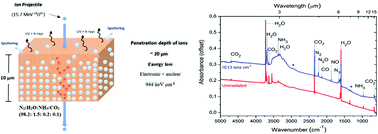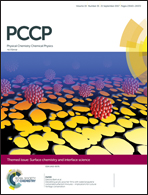Radiolysis of N2-rich astrophysical ice by swift oxygen ions: implication for space weathering of outer solar system bodies
Abstract
In order to investigate the role of medium mass cosmic rays and energetic solar particles in the processing of N2-rich ice on frozen moons and cold objects in the outer solar system, the bombardment of an N2 : H2O : NH3 : CO2 (98.2 : 1.5 : 0.2 : 0.1) ice mixture at 16 K employing 15.7 MeV 16O5+ was performed. The changes in the ice chemistry were monitored and quantified by Fourier transformed infrared spectroscopy (FTIR). The results indicate the formation of azide radicals (N3), and nitrogen oxides, such as NO, NO2, and N2O, as well as the production of CO, HNCO, and OCN−. The effective formation and destruction cross-sections are roughly on the order of 10−12 cm2 and 10−13 cm2, respectively. From laboratory molecular analyses, we estimated the destruction yields for the parent species and the formation yields for the daughter species. For N2, this value was 9.8 × 105 molecules per impact of ions, and for the most abundant new species (N3), it was 1.1 × 105 molecules per impact of ions. From these yields, an estimation of how many species are destroyed or formed in a given timescale (108 years) in icy bodies in the outer solar system was calculated. This work reinforces the idea that such physicochemical processes triggered by cosmic rays, solar wind, and magnetospheric particles (medium-mass ions) in nitrogen-rich ices may play an important role in the formation of molecules (including pre-biotic species precursors such as amino acids and other “CHON” molecules) in very cold astrophysical environments, such as those in the outer region of the solar system (e.g. Titan, Triton, Pluto, and other KBOs).



 Please wait while we load your content...
Please wait while we load your content...